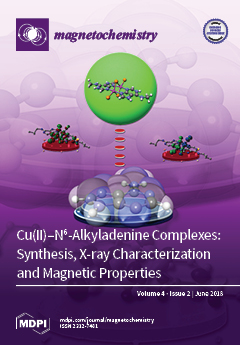A lantern-type diruthenium(II,III) complex [Ru
2(HNOCPh)
4(BF
4)(H
2O)] was prepared from [Ru
2(HNOCPh)
4Cl]
n by removal of the axial chlorido-bridge using AgBF
4 in THF. The room temperature magnetic moment (per Ru
25+ unit)
[...] Read more.
A lantern-type diruthenium(II,III) complex [Ru
2(HNOCPh)
4(BF
4)(H
2O)] was prepared from [Ru
2(HNOCPh)
4Cl]
n by removal of the axial chlorido-bridge using AgBF
4 in THF. The room temperature magnetic moment (per Ru
25+ unit) of [Ru
2(HNOCPh)
4(BF
4)(H
2O)] is 3.84 μ
B, which is similar to that (4.15 μ
B) of [Ru
2(HNOCPh)
4Cl]
n, for which magnetic measurement was newly performed in this study. These results indicate that both of the complexes have a spin state of
S = 3/2, although temperature-variable (VT) magnetic moments (2–300 K) showed that considerable antiferromagnetic interaction (
zJ = −2.8 cm
−1) exists through the axial chlorido-bridge for [Ru
2(HNOCPh)
4Cl]
n, but such a large interaction (
zJ = −0.08 cm
−1) does not exist for [Ru
2(HNOCPh)
4(BF
4)(H
2O)], where the large zero-field splitting
D = 61 cm
−1 is operative for both complexes, like other lantern-type diruthenium(II,III) complexes. The X-ray single-crystal structure analysis of [Ru
2(HNOCPh)
4(BF
4)(H
2O)]·2(acetone) showed that the axial positions of the complex were occupied by a fluorine atom of the BF
4− ion and an oxygen atom of the water molecule, with distances of Ru-F
ax = 2.3265(19) Å and Ru-O
ax = 2.280(2) Å, respectively. The Ru-Ru bond distance was 2.2793(4) Å, which is shorter than those (2.295(2) and 2.290(2) Å) reported for [Ru
2(HNOCPh)
4Cl]
n. The quartet ground states (
S = 3/2) were reasonably interpreted for [Ru
2(HNOCPh)
4(BF
4)(H
2O)] and [Ru
2(HNOCPh)
4Cl]
n, as well as the theoretically modeled complex cation [Ru
2(HNOCPh)
4]
+, by DFT calculation results. A Ru
26+/Ru
25+ redox couple was observed at 1.12 V (vs. SCE) for [Ru
2(HNOCPh)
4(BF
4)(H
2O)] in dichloromethane containing Bu
4NPF
6 as electrolyte.
Full article





